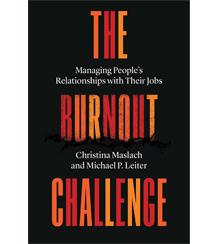Profiles in burnout
In their new book, leading experts Christina Maslach and Michael Leiter bring academic rigor to organizational responses to employee overload.

The Burnout Challenge: Managing People’s Relationships with Their Jobs
by Christina Maslach and Michael P. Leiter, Harvard University Press, 2022
After New Zealand Prime Minister Jacinda Ardern unexpectedly announced her resignation on January 19, the lead on CNN’s analysis read, “Burnout is real—and it’s nothing be ashamed of.” Indeed.
It would have been more surprising if the PM had, as she described it, “a full tank, plus a bit in reserve for those unplanned and unexpected challenges that inevitably come along.” After all, she led New Zealand through a series of major crises, including the covid-19 pandemic and the Christchurch mosque shootings, which were the worst terrorist attacks in the country’s history. She endured extreme abuse online and received an unprecedented number of personal threats—so many that she may be the first ex-PM in New Zealand to require high levels of security. And she became a parent while PM, giving birth to a daughter, now four years old.
Going by The Burnout Challenge, by Christina Maslach and Michael Leiter, Ardern’s five-year-plus run as PM was a perfect storm for burnout. The authors should know. Maslach, who is professor of psychology emerita at University of California–Berkeley, created the Maslach Burnout Inventory, the first and leading burnout assessment, in 1981. Leiter, who was a professor of organizational psychology at Australia’s Deakin University and held the Canada Research Chair in Occupational Health at Acadia University, has been researching burnout—and collaborating with Maslach—for almost as long.
The word burnout gets thrown around pretty loosely, often referring to the exhaustion and disillusionment with work that many of us experience at one time or another versus a chronic, debilitating syndrome. Maslach and Leiter frame and define this syndrome as arising from mismatches in the relationship of employees with their jobs. They identify three dimensions of this relationship: the capability dimension, which is governed by workload and control; the social dimension, governed by reward and community; and the moral dimension, governed by fairness and values. When any one of these dimensions break down (like when you add managing a global pandemic to your workload as leader of a country and your constituents start sending you death threats and you can’t be the parent you always wanted to be), the result, write the authors, can be “an employee experience of a crushing exhaustion, feelings of cynicism and alienation, and a sense of ineffectiveness—the triumvirate known as burnout.”
If you want to get a rise out of Maslach and Leiter, take the approach to addressing burnout that most companies follow: pin it to the individual experiencing it, and try to fix the person. The authors call this the “medicalization of burnout,” even though, they add, “there is no comprehensive body of evidence to support the idea that burnout is a disease.”
Instead, Maslach and Leiter argue that a worker experiencing burnout is akin to a canary in a coal mine. “Like the canary, a person experiencing burnout could be considered a harbinger, a sensor sounding an early warning that something is going wrong more generally,” write the authors. “To resolve problems of burnout, we must heed the canary’s distress and investigate, with both the mine and the canary in mind.”
Maslach and Leiter argue that a worker experiencing burnout is akin to a canary in a coal mine.”
This kind of investigation requires a refocusing of corporate attention. First, there must be a shift from what may be wrong with the person experiencing burnout to what may be wrong with the relationship between the person and their job. Second, there must be a shift to “both-and” thinking—that is, the roles that both the person and the job play in creating and alleviating burnout. And lastly, refocusing corporate attention requires a shift from what’s wrong to what’s right in the person–job fit. “It may be easier to point out what’s wrong (and moan and groan about it) than it is to point out what would be right,” write Maslach and Leiter, “but working to generate positive solutions is essential if things are going to be changed for the better.”
Toward this end, Part II of The Burnout Challenge is devoted to explaining what can be done to repair each of the six areas (workload, control, reward, community, fairness, and values) in which person–job mismatches occur. This is typified in its extreme forms by the Japanese word karoshi (“death due to overwork”) and the 996 schedule (a controversial work week of six 12-hour days) reportedly required by some companies in China. When mismatches manifest in workload, the authors advise focusing on recovery to restore worker well-being. They also advocate establishing a better balance between “resources and demands,” as well as clear boundaries between work and nonwork, to maintain that balance.
As you might expect given the expertise and experience of the authors, The Burnout Challenge does an admirable job of laying out the profiles of burnout (and their causes and remedies). But it does speak exclusively to how leaders can better understand and help the roughly 10 to 15% of employees who suffer from burnout across industries. It doesn’t, however, address burnout at the top of the corporate hierarchy. Although it is surely too reductive to attribute Jacinda Ardern’s surprise resignation to burnout alone, it is possible that she might have had enough gas in the tank to face the challenges in the remainder of her term if all three dimensions of her relationship with the job of running New Zealand hadn’t broken down all at once.
So, what should happen when top leaders fall prey to burnout? Does the board change the job? Send the CEO on a vacation? Or just accept that resignation letter? Maybe senior leaders are the exceptions to the approach to burnout that Maslach and Leiter describe. When top canaries keel over in their coal mines, perhaps they need to resuscitate themselves.
Author profile:
- Theodore Kinni is a contributing editor at strategy+business. He also blogs at Reading, Writing re: Management.





